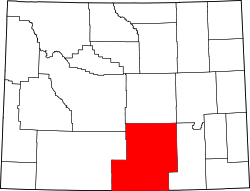Three Forks, Wyoming | |
|---|---|
| Coordinates: 42°21′45″N107°26′41″W / 42.36250°N 107.44472°W | |
| Country | |
| State | Wyoming |
| County | Carbon |
| Elevation | 6,277 ft (1,913 m) |
| Time zone | UTC−7 (MST) |
| • Summer (DST) | UTC−6 (MDT) |
Three Forks is an unincorporated community in Carbon County, Wyoming, United States. [1]
Three forks, locally known as Three Forks Muddy Gap, was named from its location at a fork in the road. [2] First settled in 1935 when Highway 287 was built. Local Rancher, Robert L. Tully built a small filling station. Then in his sixties, Tully decided to retire from ranching, selling off much of his original homestead to pay for the construction of the station.


